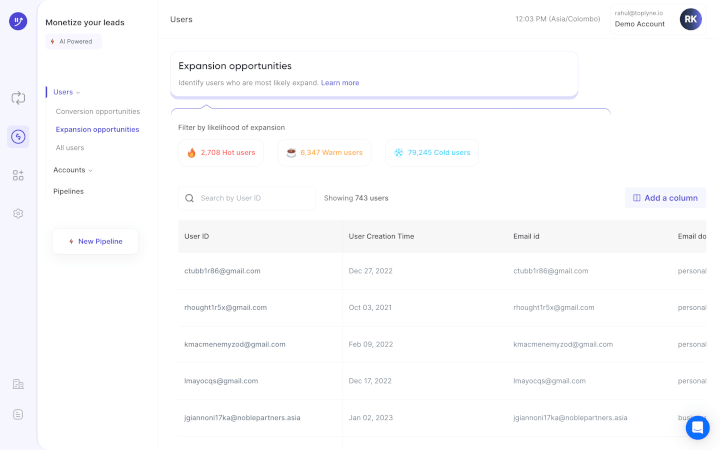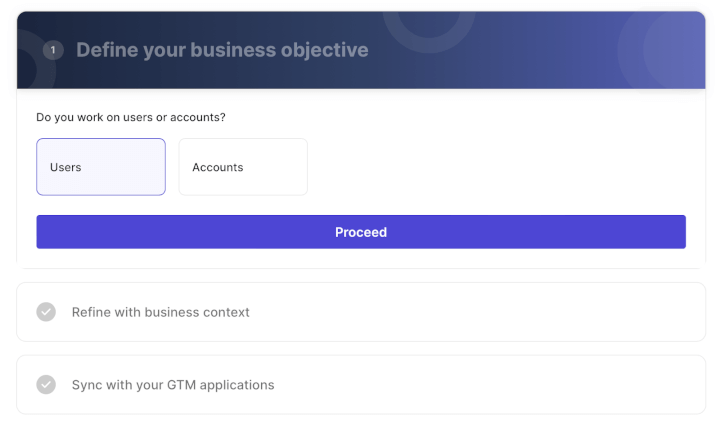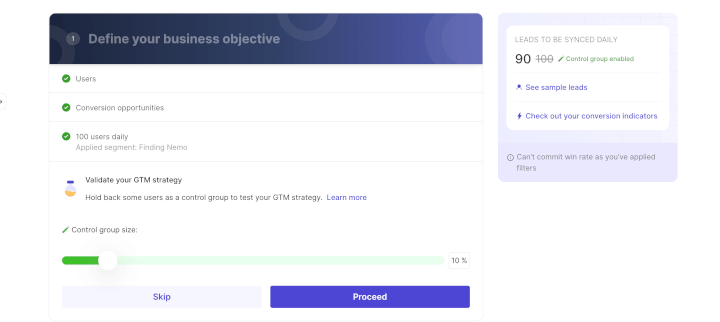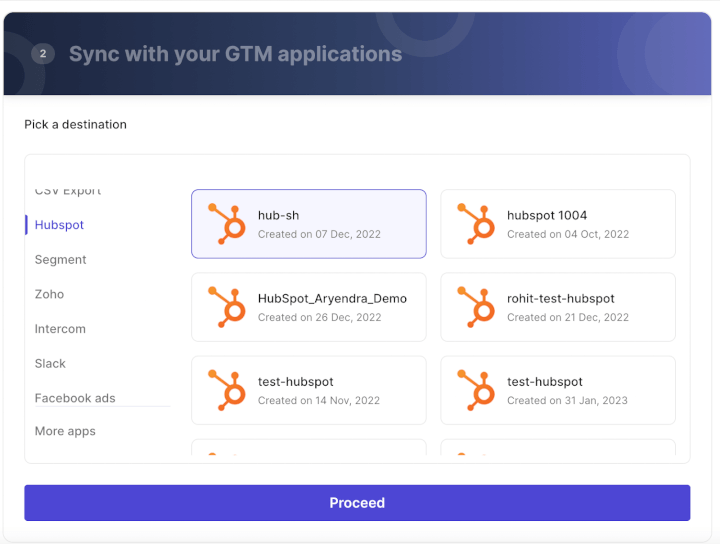5 Freemium SaaS Companies & The Keys to Their Success

Let’s be honest: A freemium product isn’t easy to nail down.
For starters, your freemium plan must have enough functionality to attract users while still pushing them to upgrade. 📈
If it solves all their problems, users will stick to the freemium product forever!

So how did some of the most successful freemium SaaS companies get it right?
In this ultimate guide, we’ll cover what freemium is and some of the biggest companies that have got the business model down to a tee. 😎 We’ll also cover the benefits of the freemium model and help you figure out if freemium is right for you.
We’ll even introduce you to a powerful tool that helps convert free users into paying customers — instantly! 💸
What is Freemium?
Freemium is a pricing strategy that offers a free and paid version of a platform’s products.
Products with a freemium model:
- Offer limited functionality — incentivizing customers to upgrade. 🔼
- Give every user access to the free plan forever. 🆓
- Encourages every user to find value in the free product and upgrade when it makes sense. 😌
- Are used as an alternative to free trials. ↖️↗️
But wait!
How is the freemium pricing model different from a free trial?
Simple.
Free trial users get access to almost every premium feature, but only for a limited time (usually seven days). Freemium companies offer every user free lifetime access to basic features of their product, but users need to upgrade to paying customers to access any premium feature.

Freemium business model crash course — done!✅
Now let’s look at five examples of today’s biggest freemium SaaS companies and how they nailed this pricing strategy.
Five Freemium SaaS Companies That Knocked It Out Of The Park
Here are five SaaS companies that became wildly successful using a freemium model.
- Dropbox
- HubSpot
- ClickUp
- Zoom
- MailChimp
1. Dropbox
Dropbox is one of the world’s largest cloud storage service providers — and one of the most successful freemium businesses.
The freemium product helps individuals and large organizations store and manage data — as well as collaborate with others on projects. 🤝
Dropbox has a free plan that gives every user 2GB of storage. They also offer six tiers of the paid version — three each for businesses and individuals.
How does Dropbox’s freemium strategy work? 🤔
A user signs up for the freemium plan and uses the free 2GB storage to manage their data. Once the user reaches the storage limit, they’ll likely upgrade to a paid plan and become one of Dropbox’s paying customers.
Why?
They’ve already stored most of their data on the platform, and switching to another data storage platform takes too much time and effort. Plus, Dropbox offers many enticing additional features like unlimited device linking and advanced sharing controls for premium users.

So, what’s the takeaway here?
If you think users will upgrade after they spend more time on the free version, introduce a freemium plan. Add a free-use limit instead of limiting how much time freemium users can spend on the platform. This will help you boost your number of paying customers.
Paid user plans start at $11.99/month for individuals and $18/month/user for businesses. 💰
2. HubSpot
If you work in SaaS, you’ve probably heard of HubSpot CRM.
HubSpot is one of the most popular freemium companies, offering tools for marketing, CRM, sales, customer support, and operations — all in one place.
If HubSpot could speak:

Organizations can use just one of the solutions HubSpot offers or bundle them together into one discounted package. 💸
They have a freemium version for each category, including free tools.
So, how does HubSpot make the SaaS freemium model work? 🤔
Simple!
Businesses sign up for a free version of a tool or a free tool bundle. As the business grows and capacity expands, the team can tailor HubSpot’s paid user plans to suit their needs and become paying customers. 🪡
You might be wondering:
Why doesn’t every user just switch to another tool once they’re ready to expand?
They won’t shift to a competitor because they’ve gotten used to HubSpot’s interface and processes — not to mention that all their user data is already stored on HubSpot’s platform!
What can we learn from HubSpot?
If your offering includes several tools for various functions - consider adding a free version for each tool.
This way, free users become familiar with the freemium version and when they need more tools, becoming paying customers of your platform becomes a no-brainer.
HubSpot’s pricing for paid bundles starts at $50/month for two paid user accounts. 💲
3. ClickUp
ClickUp is one of those rare freemium companies with a tool that can do everything! 😁
Any ClickUp user can create tasks, docs, whiteboards, and kanban boards — and even chat and email team members within the platform!
But wait, there’s more!
The tool also has additional features like in-app video recording and native time tracking to help your team stay productive.🧑💼
But how does ClickUp make money by giving all this away for free to every user? 🤔
Here’s the catch.
While the free plan lets any user create unlimited tasks, every premium feature — like increased storage and dashboards -- is reserved for paying customers who press that shiny upgrade button.
Additionally, ClickUp is so multi-functional that tons of businesses centralize their entire workflow on ClickUp.
And when a team spends a considerable amount of time on ClickUp’s free product, upgrading isn’t a matter of if — but when. 🕰️
![[optimize output image]](https://cdn.prod.website-files.com/65a80db6a97ea2f4fd5302cd/65a80db6a97ea2f4fd531075_64ad85b17af0936ba94da4e0_6377e6f26755ae24cf3cbe7a_ezgif-3-bb85b4f113.gif)
ClickUp has three standard paid tiers for paying customers and an enterprise category.
What’s the lesson to learn from ClickUp’s revenue model?
Don’t limit your tool to just one function. Develop your product to a point where it becomes critical for businesses. Develop a high level of customer success so users will rarely churn from your product.
Pricing for the standard plans starts at $9/user/month.💲
4. Zoom
Remember how we spent 2020 talking with our mics on mute?

Yep, we’ve all been through this. 😶
While Zoom was founded over a decade ago, global lockdowns caused the app to go viral in 2020 — and the SaaS company hasn’t stopped growing since. 📈
Zoom boasts an insane set of features for a video conferencing platform — from webinars that support thousands of people to in-call polling features and team collaboration tools.
How did this app zoom to the top of the freemium ranks? 🤔
Zoom’s free plan gives every user access to free calls. But there’s a catch.
For any call with more than two participants, the free product has a 40-minute time limit. But you still get most perks like whiteboards, file sharing, and additional features for collaboration.
This gives individuals and professionals a chance to experience Zoom’s value proposition and decide whether they want to upgrade. 🤝
Zoom also uses a neat trick to go viral among free users. 🤓
Whenever a Zoom user shares a meeting link, the recipient can join the meeting without sharing personal information.
This way, every Zoom user spreads the word and gets non-users to try it out!
Not only does this make Zoom meetings easier to join, but it also boosts awareness about the tool. 😎
What can you take from Zoom’s SaaS pricing strategy?
Equip each new user with tools to share your product with non-users. Even if you enable limited functionality for non-users, you’ll build awareness of your product.
More people will see your product’s value and decide to onboard as freemium users and, eventually - upgrade.
Zoom’s SaaS pricing model has three paid version tiers. Pricing starts at $14.99/month/user. 💲
5. MailChimp
MailChimp is a SaaS company that started as an email marketing tool but now is a marketing and automation platform that helps businesses turn leads into paying customers. 💸
With MailChimp, businesses can send out email campaigns using pre-built templates, create landing pages and ads, use advanced analytics and create personalized user journeys to boost customer acquisition.
How does MailChimp make its SaaS freemium model work? 🤔
MailChimp’s free plan allows every user to create email campaigns with pre-built email templates and send mass emails to a maximum of 500 contacts.
Good to start with, but not enough if you’re skyrocketing your customer acquisition efforts!
For scaling businesses that need advanced features like A/B testing, automated emails for various stages of the buyer funnel, and priority customer support, they can easily upgrade to a paid plan. 📈
What’s the main takeaway from MailChimp’s freemium model?
Enable enough functionality for every user to see how useful your product is - but ensure you incentivize them to convert to a paid plan.
MailChimp has three paid version tiers that can be tailored to any business, with pricing starting at $11/month.
So there you have it — 5 SaaS companies rocking the freemium strategy.
But is the SaaS freemium model really profitable?
Let’s look at a real-world example — MailChimp’s growth figures.
MailChimp didn’t offer a freemium pricing model until about eight years after its inception. 😯
When they finally did introduce the freemium pricing model, their paying subscribers increased by 150% and profits increased by 650%! 🚀
That should give you a good idea of why SaaS companies use the freemium model.
Still unclear? 😦
Don’t worry! We got you.
Why Do SaaS Companies Use the Freemium Model?
Here are the biggest reasons why businesses have a freemium offering:
- The free version attracts tons of free and premium users compared to a free trial. 🚀
- Companies can use feedback and usage data from free users to improve their products — resulting in high customer success and increased recurring revenue. 🔧
- A freemium business model helps firms transition to a Product-Led Growth (PLG) strategy, reducing their paid customer acquisition cost.
- Retention rates increases since customers know exactly what to expect from the product. 🤝
SaaS companies can get tons of advantages by shifting to a freemium business model — but is a freemium offer the right choice for your SaaS product?

Let’s find out!
When Should You Use a Freemium Strategy?
Here’s when your SaaS product needs a freemium sales strategy:
- When your product is easy to understand and use. 🤓
- When you’re in a competitive niche. 🌎
- When your product doesn’t require extensive customer success efforts. 😎
If your product meets several of the criteria, it’s time to adopt a freemium strategy and skyrocket your customer base. 🚀
Deploy the freemium version. Increase your user base.
But what’s next?
Convert those free users to paying customers, of course!
And that’s where we’ve got you covered.
How to Seamlessly Convert Free Users into Paying Customers
Look.
We get it.
Chasing every potential customer and getting them to sign up for your SaaS product is not just expensive and time-consuming — it’s downright exhausting. 😫

But you don’t need to do that anymore! 😎
Say hello to Toplyne!
Toplyne is a platform that helps teams identify power users and the best go-to-market (GTM) strategies to turn them from freemium users to premium users.
With Toplyne, you’ll only chase down the best leads guaranteed to bring in revenue. 🚀
Here’s how companies like Canva and Vercel generate sales pipeline from their self-serve funnel using Toplyne:
- Step 1/7: Create monetization playbooks to surface conversion and expansion opportunities (leads most likely to convert to paying customers, and teams most likely to grow into larger teams)

- Step 2/7: Choose the right leads to target – users (individual users) or accounts (a group of users with an organization).

- Step 3/7: Select the frequency at which you would want leads synced in your GTM apps.

- Step 4/7: Define how many leads you want by either the number of leads or your expected win rate, depending on your sales capacity and GTM strategy.

- Step 5/7: Build custom segments - Build custom segments based on And/Or logic at the deepest level of sub-properties within your product analytics.

- Step 6/7: Validate your GTM strategy - Hold back some users as a control group to test your GTM strategy.

- Step 7/7: Sync your product qualified pipeline into your GTM destinations - CRMs, sales & marketing execution tools, and customer engagement platforms.

Get the picture?
With Toplyne, sales teams uncover expansion and conversion pipeline from product usage data - and your team will always convert the leads they chase.
We think that’s a reason to celebrate - don’t you? 😏

Join the List of Kick-Ass Freemium SaaS Companies Today!
Freemium is a great SaaS pricing model that ensures you attract tons of free users to your platform. 😎
But free users aren’t going to pay the bills!
The best freemium SaaS companies understand their product’s value and know how to market it to get users to upgrade.
And you can do it too!
Psst…all you need is a tool like Toplyne by your side! 😉
With Toplyne, you’re guaranteed to boost conversion rates. 📈
So, what are you waiting for?
Sign up with Toplyne for free and watch your revenue take to the skies!
![[optimize output image]](https://cdn.prod.website-files.com/65a80db6a97ea2f4fd5302cd/65a80db6a97ea2f4fd531071_64ad85b17af0936ba94da4dd_6377e8e19ff3dca1241d56d6_ezgif-3-720dfaa56a.gif)


.svg)









.png)